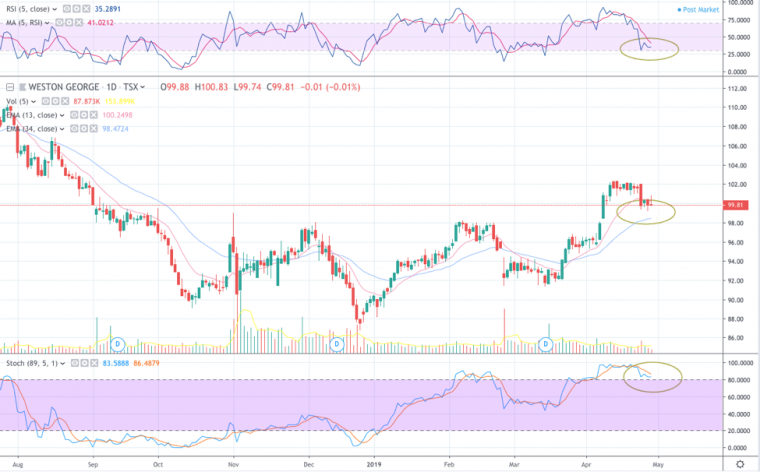by Martin Noël, Option Matters
Martin Noël
May 16, 2019
241 Views
0 Comments
5 minutes read

As the following chart shows, the price of shares in George Weston Limited (WN) is down slightly from its recent high of $102.30, and it could stabilize at a support level of around $98.00.
This is close to the current level of its 34-day moving average (on April 29, 2019). Furthermore, we can see that the stock’s RSI 5 (Relative Strength Index over five trading sessions) is approaching the oversold level, while its stoch indicator 89 (the stochastic indicator over 89 trading sessions) is still showing upward momentum above 80.
An investor who is confident in the company’s fundamentals, who is not afraid to buy shares at about $98, and who believes that the stock still has growth potential in the medium to long term could profit from this situation by writing put options with a strike of $98. The puts would oblige the investor to buy 100 shares per put contract written, in exchange for which he would receive a premium to cover the assumed risk. Receiving this premium is nothing short of being paid to buy the shares if their closing price on expiry of the options is less than the $98 strike.
Furthermore, this position allows the investor to profit from both a rebound in prices and from relatively stable prices. If the closing price is higher than the strike, the investor will realize the maximum profit on the strategy, which is equal to the premium received.
Chart 1: Changes in the price of WN as at April 29, 2019 ($99.81)

Source: Tradingview.com
Position:
- Sale of 10 put options, WN 190719 P 98 at $2.05
Table 1: Profit and Loss Profile

Writing 10 put options, WN 190719 P 98 at $2.05, yields a premium received of $2,050 ($2.05 x 10 contracts x 100 shares per contract). As can be seen in the above table, this put option is currently out-of-the-money, so the $2.05 premium consists entirely of time value.
The premium provides protection against a 2.9% drop in the share price, i.e. to the strategy’s breakeven price of $95.95 (the $98 strike – the $2.05 premium).
The maximum profit on the strategy is the total credit received ($2,050), and it will be realized if WN closes at a price higher than or equal to the $98 strike on July 19, 2019. This profit represents a 2.1% return ($2.05/$95.95) for the 81-day period, or an annual return of 9.6% (2.1%/81 x 365). As we can see, the static profit, meaning the profit generated if the stock price is unchanged on expiry of the put, is equal to the maximum profit.
If the price of WN is less than the $98 strike upon expiry of the options, the investor will have to buy 1,000 shares of WN at a price of $98 each (for a total disbursement of $98,000). This represents a cost to the investor of $95.50 per share (the $98 strike – the $2.05 premium). Any drop in the share price below this level will represent a loss for the investor.
Intervention
There are three ways to manage this position. The first is for an investor who is not afraid to buy the shares if they drop in price. In this case, the position is held without taking any further action, and if the stock is trading at less than the $98 strike upon expiry of the puts, the investor is assigned the shares and simply buys them.
The second approach involves taking action if the price of WN falls significantly below the strategy’s breakeven point, by buying the put options written in order to limit one’s losses.
The third approach involves taking action if the shares begin to trade at a substantially higher price, by buying the puts sold for 10% to 20% of their initial premium (a price of approximately $0.20 to $0.40). In both of the last two approaches, the investor can write more put options if the situation still calls for it.
Good luck with your trading, and have a good week!
Come learn more about options, live in person, at the 12th Options Education Day in Montreal at the Westin Montréal Hotel on June 1st 2019.
Sign up now as seats are limited!
The strategies presented in this blog are for information and training purposes only, and should not be interpreted as recommendations to buy or sell any security. As always, you should ensure that you are comfortable with the proposed scenarios and ready to assume all the risks before implementing an option strategy.
This post was originally published at the Option Matters blog.















